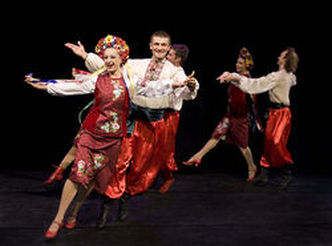Kamarinskaya, Камаринской
|
There are quite some theories about the origin of Kamarinskaya. One of them sais that it originated among the fugitive serfs (18th century) and was danced and sung with a striking recklessness and inner power.
Yet the pattern of kamarinskaya was already used in the 17th century by folk theater performers to communicate the humorous or satirical content of their rhyms. As it is believed that the Russian folk theater originated among the "skomorokhs", medieval East Slavic harlequins and actors that appeared in Kievan Rus no later than the mid-11th century, it is also believed that all songs of the kamarinskaya type are derived from old "skomorokh" songs. In 1848 Mikhail Glinka combined the kamarinskaya with a wedding song. It was the first orchestral work based entirely on Russian folk song and his creation became one of his most famous symphonic compositions: "Kamarinskaya". Though originally kamarinskaya was a dance song, in the nineteenth century it became solely a dance and nowadays it is mainly performed as an instrumental piece. |
Kamarinskaya belongs to a well-defined group of Russian folk naigrïshi, instrumental dance tunes. These typically consist of three-bar phrases, which are played in an endless number of variations in a moto perpetuo, ad infinitum fashion by an instrumentalist. Repetitive mode is very important in Russian folk music and when one thinks that it is all over, it starts again, but on a higher level. This dance-till-you-drop is typical for the naigrïsi.
The music is often played by wedding bands, or by a muzhik on a balalaika, an accordeon or a concertina to accompany a strenuous and often competitive type of male dancing. In the West this dancing is known as "typically Russian" and when Russians do perform this dance it is always in bright and colourful costumes. The performances in the west are mostly by professional folk dance ensembles.
The music is often played by wedding bands, or by a muzhik on a balalaika, an accordeon or a concertina to accompany a strenuous and often competitive type of male dancing. In the West this dancing is known as "typically Russian" and when Russians do perform this dance it is always in bright and colourful costumes. The performances in the west are mostly by professional folk dance ensembles.
|
The main dance steps of the kamarinskaya are hops, knee-bend and prisyadka, walks and heel-brush steps. But actualy it doesn't matter how it is performed, or how it is been danced: the main aspects of kamarinskaya are vituoso improvisation and emotional charge.
The first recorded song of the kamarinskaya type was "Near a Deep Ravine there grows a Snowball Tree". This song was used by Ludwig van Beethoven in his Twelve Variations on the Russian Dance for piano. Sources: Russian folk songs: musical genres and history, by Vadim Prokhorov Defining Russia musically: historical and hermeneutical essays, by R. Taruskin http://en.wikipedia.org/wiki/Kamarinskaya |
|
|
|


